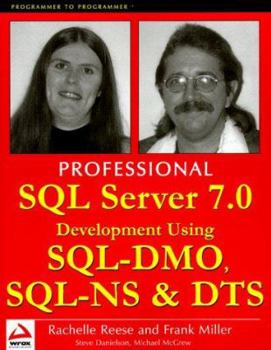Professional SQL Server 7.0 Development Using SQL-Dmo, SQL-NS and Dts
For system administrators who want an introduction to DMO and programming to enable them to move beyond the constraints of T-SQL, this guide features comprehensive coverage of the hottest topics in... This description may be from another edition of this product.
Format:Paperback
Language:English
ISBN:1861002807
ISBN13:9781861002808
Release Date:December 1999
Publisher:Wrox Press
Length:743 Pages
Weight:2.70 lbs.
Dimensions:1.6" x 7.3" x 9.3"
Customer Reviews
2 ratings
ALL I needed to know about DMO
Published by Thriftbooks.com User , 21 years ago
I had to write some programs for work that involved getting into the DMO objects of SQL Server, and this book was simply invaluable to me in understanding the objects better and helping me to produce a program that I am really proud of.I have not checked out the other sections of this book, however the books from this lot (wrox) tend to be very good, with useful, real-life examples and detailed explanations. I also used a similar book from them to learn ASP.I highly recommend this book.
Good book. Does just what it says it does.
Published by Thriftbooks.com User , 21 years ago
I was discouraged from getting this book for a while because of the other reviews on this page, but when I really needed an additional reference for SQL-DMO, I went ahead for whatever I could get from the book. I have read through the portion of the book (The chapters, not the appendices - they are more for reference). First, the book is not just a rehash of the SQL SBO, nor of the reference on MSDN. It was my frustration with searching through them, getting explanations that did not always offer enough of an example to really clear up the concept in my mind that led me to seek another book. The chapters in this book do lead the reader through examples, and do solidify the concepts I was looking to have solidified such as the practicalities of the object Heirarchy. Once you have this part firmly in mind, then MSDN, and SQL SBO's endless diagrams and cryptic descriptions begin to make more sense.As for the examples being in VB, I program in C++ and Perl. I very, very seldom use VB or any of its variants, but it is so simple that there is no problem whatsoever in translating the examples from the VB in the book to the languages I use. The object model is the same regardless of the language, the languages just have a little different notation in accessing the properties and methods. For example:VBS:Private dSrvPrivate dDbSet dSrv = CreateObject("SQLDMO.SQLServer")call AddSurvey("MyCompany", "MySurvey", "MyDbName")Call dSrv.Connect("(local)", "sa", "changed")Set dDb = CreateObject("SQLDMO.Database")dDb.Name = "myDb"dSrv.Databases.Add(dDb)'set some db options:private dbOptionset dbOption = dDb.DBOptiondbOption.SelectIntoBulkCopy = 0dbOption.TruncateLogOnCheckpoint = 0dbOption.AutoCreateStat = 0dbOption.AutoShrink = 1dbOption.AutoUpdateStat = 0MsgBox dDb.ScriptIs this in Perl:use Win32;use Win32::OLE;my $srv = Win32::OLE->new('SQLDMO.SQLServer');<p>$srv->Connect('(local)', 'sa', 'changed');<br>my $db = Win32::OLE->new('SQLDMO.Database');<br>$db->{Name} = 'MyDb';<br>$srv->Databases->Add($db);<br>my $option = $db->DBOption();<br>$option->{SelectIntoBulkCopy} = 0;<br>$option->{TruncateLogOnCheckpoint} = 0;<br>$option->{AutoCreateStat} = 0;<br>$option->{AutoShrink} = 1;<br>$option->{AutoUpdateStat} = 0;<p>Win32::MsgBox($db->Script());<p>As anyone can see that takes even a few seconds to look at those two scripts for creating a database, the object model is exactly the same. The scripts are doing exactly the same thing. The only difference is in the language syntax, and there is such a direct correlation even there that it is very easy to translate from the examples in the book into the languages I prefer to use. For C++, chapter 12 is dedicated to setting up and creating projects in C++. From there, it is just using the C++ syntax to access the same object heirarchy.<p>In my opinion, the book does what it says it does, and was helpful, and clear in developing a better understanding within me of using SQL-DMO, SQL-NS, and DTS in my development.<p>Steve Howa





